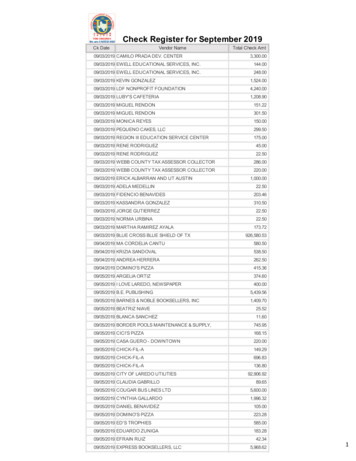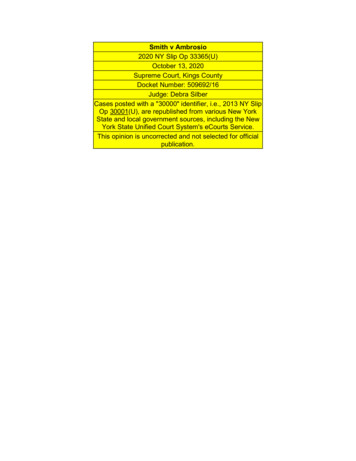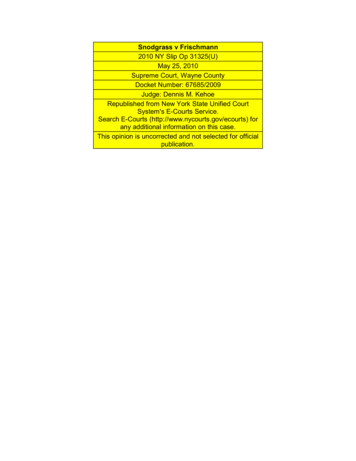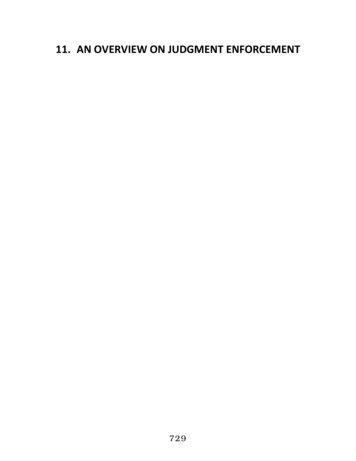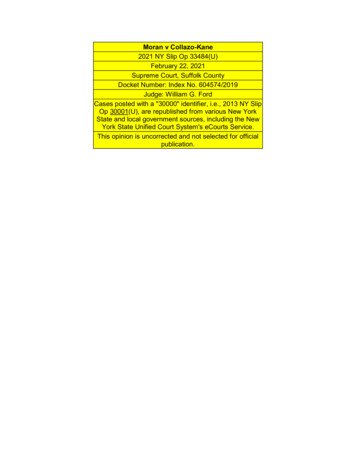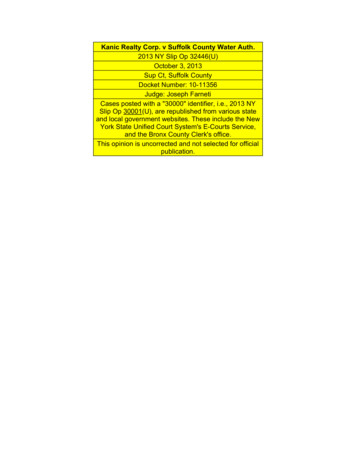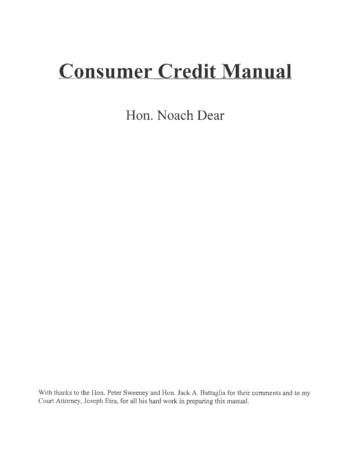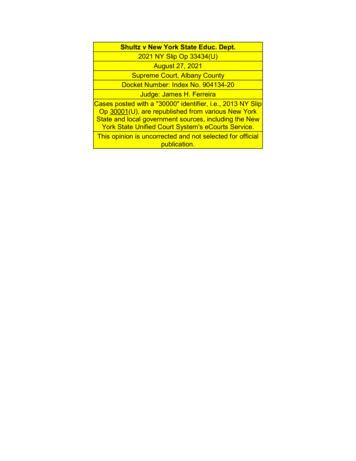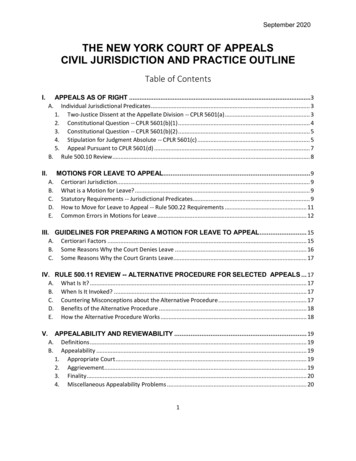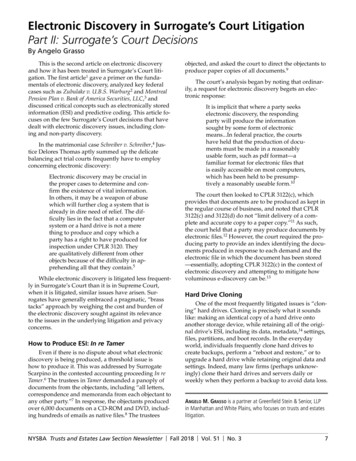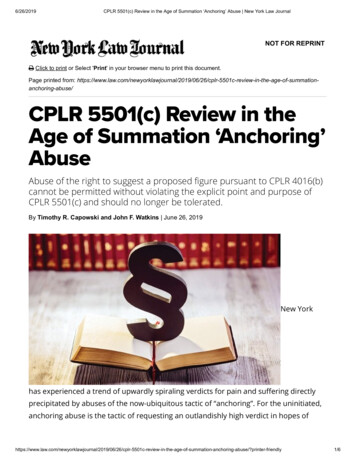
Transcription
6/26/2019CPLR 5501(c) Review in the Age of Summation ‘Anchoring’ Abuse New York Law JournalNOT FOR REPRINT Click to print or Select 'Print' in your browser menu to print this document.Page printed from: abuse/CPLR 5501(c) Review in theAge of Summation ‘Anchoring’AbuseAbuse of the right to suggest a proposed gure pursuant to CPLR 4016(b)cannot be permitted without violating the explicit point and purpose ofCPLR 5501(c) and should no longer be tolerated.By Timothy R. Capowski and John F. Watkins June 26, 2019New Yorkhas experienced a trend of upwardly spiraling verdicts for pain and su ering directlyprecipitated by abuses of the now-ubiquitous tactic of “anchoring”. For the uninitiated,anchoring abuse is the tactic of requesting an outlandishly high verdict in hopes ng-abuse/?printer-friendly1/6
6/26/2019CPLR 5501(c) Review in the Age of Summation ‘Anchoring’ Abuse New York Law Journalin ating a “compromise” number—that is, asking for 50 million for pain and su eringin hopes that the jury will consider 25 million a modest compromise, even though,historically, the Appellate Division has never permitted an award for the injury inquestion higher than 10 million under CPLR 5501(c).Anchoring exploits a tension within New York public policy as expressed in the CPLR.CPLR 4016(b) grants attorneys the express right to request “a speci c dollar amount”for pain and su ering. But CPLR 5501(c) also requires damages awards to stay withinthe bounds of “reasonable compensation”, and establishes a system whereby partieson the receiving end of an unreasonable verdict may seek review of the verdict througha comparable case analysis. Anchoring thus permits a plainti to abuse the CPLR4016(b) privilege, secure an unreasonable and unsustainable verdict, and impose thecost of further litigation of the verdict on defendants, while burdening the courts.Anchoring accomplishes all of this with no downside to its proponent, as the probableoutcome of even the most egregious anchoring requests is simply a remittitur to thehigh end of the sustainable range, which is itself a perverse reward for an impropercomment. Over time, the consistent reduction of these verdicts to the high end of therange drives the range upward, bene tting the plainti bar and undercutting CPLR5501(c)’s stated purposes to increase fairness to all litigants, normalize award ranges,prevent upward spiral, reduce uncertainty, and decrease litigation and courtcongestion.The courts have yet to address this issue. We suggest, however, that anchoring’s illsrequire a reconceptualization of CPLR 4016(b) that is consistent with CPLR 5501(c). Thesuggestion of an unreasonable verdict gure is improper and in ammatory, akin to anyother unreasonable or improper statement by an attorney to the jury during trial, andmust carry consequences to prevent its recurrence and a remedy to counter the unfairprejudice.The More You Ask For, The More You GetAnchoring works. Over the past 40 years, psychologists studying this topic (alsoreferred to as “adjustment bias”) have consistently concluded as much. Anchors serveto simplify judgments that involve uncertainty or have little to no objective horing-abuse/?printer-friendly2/6
6/26/2019CPLR 5501(c) Review in the Age of Summation ‘Anchoring’ Abuse New York Law JournalPeople often rely on an anchor when making quantitative judgments. Alternative awardproposals can somewhat “counterbalance” the anchor, but the anchor will still in uencethe ultimate award. Gary Giewat, et al., “Alternative Damage Awards: Worth the Risk?,”36 Westchester B.J. 21, 22 (2009); see Consorti v. Armstrong World Industries, 72 F.3d1003 (2d Cir. 1995), vacated on other grounds 518 U.S. 1031 (1996); see also GretchenChapman and Brian Bornstein, “The More You Ask For, the More You Get: Anchoring inPersonal Injury Verdicts,” 10 Applied Cognitive Psychol. 519 (1996); Don Rushing, et al.,“Anchors Away: Attacking Dollar Suggestions For Non-Economic Damages,” 70 Def.Couns. J. 378 (2003); John Campbell, et al., “Countering the Plainti ’s Anchor: JurySimulations To Evaluate Damages Arguments,” 101 Iowa L. Rev. 543 (2016).The Second Circuit expressed concerns regarding anchoring in Consorti, 72 F.3d 1003.Plainti asked for and received a grossly excessive 12 million pain and su eringverdict that was reduced on appeal to 3.5 million pursuant to CPLR 5501(c). The courtobserved its discomfort with the fact that “[s]uch suggestions anchor the jurors’expectations of a fair award at a place set by counsel, rather than by the evidence.” Id.at 1016. “A jury is likely to infer that counsel’s choice of a particular number is backedby some authority or legal precedent. Speci c proposals have a real potential to swaythe jury unduly.” Id.Quite simply, the more you ask for, the more you get. The success of anchoring is nolonger subject to debate—virtually every personal injury summation now includes sucha request. For the same reason, the inadequacy of existing tools to combat anchoring—such as the standard jury charge that a request is not evidence—is likewise no longerup for debate.CPLR 5501(c) Policy and HistoryCPLR 5501(c) was speci cally enacted to stop the upward spiral of awards, and totighten and normalize awards within a reasonable compensation range. The intentionwas that simpli ed valuation of injuries would lead to less uncertainty, greaterevenhandedness and greater fairness to similarly-situated plainti s and n-anchoring-abuse/?printer-friendly3/6
6/26/2019CPLR 5501(c) Review in the Age of Summation ‘Anchoring’ Abuse New York Law Journalless litigation, more settlements, and reduced strain on scarce judicial resources. SeeConsorti, 72 F.3d at 1009-10, 1016; Gasperini v. Ctr. for Humanities, 518 U.S. 415, 42325 (1996).In applying CPLR 5501(c) over the 33 years since its enactment, the appellate courtshave only twice permitted pain and su ering awards in excess of 10 million: a 16million award in the First Department (involving catastrophic burn injuries), and a 12million award in the Fourth Department (involving a young quadriplegic). Setting asidethose two outliers, 10 million has essentially served as a CPLR 5501(c) hard cap forpain and su ering for the most catastrophic of injuries over the last three decades.Even that gure has only been approved (after remittitur) ve times (three times by theFirst Department and once each by the Second and Fourth).Anchors AwayDespite the foregoing, counsel in recent years have nevertheless repeatedly requestedthat juries return verdicts in the tens of millions for various injuries. Indeed, it is nowbecoming commonplace to see counsel request pain and su ering verdicts of 10million to 20 million for injuries that have been consistently valued by the relevantappellate venue in the six- gure to 2 million range.Such requests are unreasonable per se, but made with impunity because courtsre exively construe CPLR 4016(b) to permit them. Treating CPLR 4016(b) this way gutsCPLR 5501(c)’s fundamental purpose and leads to an absurdity. Because absurdities areto be rejected, CPLR 4016(b) should be construed to incorporate a CPLR 5501(c)reasonability limit to harmonize the two. See McKinney’s Statutes §145, Absurdity (“Aconstruction which would make a statute absurd will be rejected.”); Statutes §144,Ine ectiveness; Statutes §143, Unreasonableness.Litigation Burden and the Resulting Unfair PrejudiceDefendants have no choice but to use CPLR 5501(c) to contest excessive pain andsu ering verdicts generated by improper anchoring. This inevitably clogs our alreadyoverburdened New York state court system with damages controversies. ring-abuse/?printer-friendly4/6
6/26/2019CPLR 5501(c) Review in the Age of Summation ‘Anchoring’ Abuse New York Law Journalsuccessful CPLR 5501(c) contests, however, do not make a defendant whole. This isboth because of the cost of litigation and the traditional application of remittitur.In typical remittitur situations, the reviewing court reduces the excessive awards to theupper end of the sustainable range. Siegel’s New York Practice §407, “Additur andRemittitur” (Third Ed.), p. 658 (“The gure set by the court, and the one to which theparty is required to stipulate or face a new trial, represents the minimum (in the case ofadditur) or the maximum (in the case of remittitur) found by the court to be permissibleon the facts.”). The forgiving remittitur rule derives from the “light most favorable”standard of review, which assumes the jury wholeheartedly accepted the prevailingparty’s evidence but simply awarded more than could be sustained as reasonablecompensation (remittitur). Thus, a plainti in possession of an excessive verdict has nodownside: defeat in a CPLR 5501(c) proceeding leaves plainti with a maximum verdict.It should come as no surprise, therefore, that abusive anchoring tactics have becomethe new norm.A New Approach to Anchoring AbuseRemittitur, thus applied, cannot stop an upward spiral; it merely slows its advance. Assuch, better tools are required to shield the CPLR 5501(c) policy goal from abusiveanchoring.One option is to expand the awarding of mistrials or new trials on damages in responseto improper anchoring. Su ciently egregious anchoring should warrant a new trial onliability as well. Courts have recognized that a damages verdict occasioned byin ammatory or improper summation or trial conduct guts the rationale behind the“light most favorable” review standard and warrants a new trial on all counts, to ensurean untainted result. See, e.g., Smith v. Rudolph, 151 A.D.3d 58, 63 (1st Dep’t 2017). Thesame logic applies where the excessive pain and su ering verdict is occasioned by ajury in amed or misled by suggestion of an arti cially high damages gure. SeeRangolan v. County of Nassau, 370 F.3d 239, 244-45 (2d Cir. 2004) (remittitur to highestsustainable only appropriate where “the excess [verdict] is not attributable to adiscernable -anchoring-abuse/?printer-friendly5/6
6/26/2019CPLR 5501(c) Review in the Age of Summation ‘Anchoring’ Abuse New York Law JournalA second remedy is required, however, to protect the courts from the glut of litigationcaused by endless contests of these in ated verdicts. We propose two: (1) remittitur tothe middle or lower end of the sustainable range in cases involving improperanchoring, and (2) the award of attorney fees where an anchoring request departs fromgood faith. Either would force plainti s to think carefully before anchoring, andincentivize them to properly suggest a gure tethered to the sustainable “reasonablecompensation” spectrum established by the Appellate Division through the applicationof CPLR 5501(c).ConclusionIn sum, abuse of the right to suggest a proposed gure pursuant to CPLR 4016(b)cannot be permitted without violating the explicit point and purpose of CPLR 5501(c)and should no longer be tolerated. Anchoring abuse will either be checked by theCourts or, failing this, will ultimately lead to the legislative implementation of caps ondamages that CPLR 5501(c) might otherwise have obviated.Timothy R. Capowski and John F. Watkins are appellate partners at Shaub, Ahmuty,Citrin & Spratt.Copyright 2019. ALM Media Properties, LLC. All rights anchoring-abuse/?printer-friendly6/6
6/26/2019 CPLR 5501(c) Review in the Age of Summation 'Anchoring' Abuse New York Law Journal plr-5501c-review .

